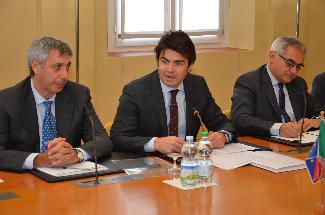
The 2017 figures for ceramic tiles
Investments grow while production and sales remain stable thanks to a strong export performance. The renewal of antidumping duties is essential to ensure fair trade and a level international playing field
Production and total sales continued to recover in 2017, growing by more than 2 percentage points with respect to 2016 thanks to slightly higher than average export growth and a domestic market that closed the year positively despite a slowdown during the entire 12 month period. This was the picture that emerged from the preliminary results analysed by Prometeia, which forecasts further growth of around a percentage point in 2018 in terms of all variables except for domestic turnover, which is expected to remain steady at current levels. These were just a few of the key findings presented today during the Confindustria Ceramica end-of-year conference based on the studies and analyses conducted by the association’s Research Department in collaboration with Prometeia and BPER Banca Spa.
The economic and financial situation in 2016
The BPER Banca financial statement analysis reveals an improvement in the sector’s structure over the last three years. Average turnover has risen (+21% since 2007) with EBITDA standing at 14% in 2016 (albeit with significant differences between large and small companies), bringing the net financial position back to normal levels.
But the most striking figure is once again that of investments, with the sector expecting to further improve on last year’s record figure by exploiting the opportunities offered by the Industry 4.0 trend and focusing on the production of large panels and slabs.
The 2017 figures for ceramic tiles
The preliminary figures published by Prometeia based on sector data show that the Italian ceramic tile industry generated output volumes and sales of around 425 million square metres, consisting of approximately 340 million square metres of exports and 85 million square metres of domestic sales. One new development is the fact that sales have grown in all export markets, particularly in Central and Eastern Europe (by more than 5%) and in the Far East (3.5%). The forecasts for 2018 point to approximately one percentage point higher growth in production and sales, which are expected to increase by around +3%, driven mainly by exports. The Gulf states and north Africa are amongst the most dynamic export markets.
The Chairman’s comment.
“The macroeconomic outlook described by Prometeia based on current information suggests that growth will continue in 2018, albeit at lower values than the recent past. Our traditionally strongest markets (USA and Germany) are experiencing slower growth, while our strongest export performance is in the Gulf states, India and North Africa. This means we must focus more closely on non-traditional destinations.
“Non-residential building is showing an interesting trend at an international level and may offer growing potential for ceramic panels, a technology that our sector is continuing to develop. “The Italian market currently stands at 50% of pre-crisis volumes and requires a change of pace and adequate resources to make the energy and seismic incentives permanent and to exploit the new opportunities that are now extended to apartment buildings. New investments are needed to redevelop our cities and to kick-start our country’s construction industry.
“In recent weeks it was announced that the antidumping duties on Chinese imports will be extended until 2022, a vital measure to ensure fair trade and to give certainty and stability to the industry at a European level. However, the trade protection measures approved by the European Commission display both positive and negative aspects. While the agreement for the new procedure to be adopted in antidumping cases resolves the issue of recognition of market economy status, its real application potential remains to be seen and there continue to be significant doubts regarding certain technical aspects of the antidumping duties.
“The measure redefining the electricity charges applied to high energy consuming companies was eagerly awaited by our sector and by the Italian manufacturing industry as a whole. The provision signed on 30 November by Minister Carlo Calenda supersedes the previous approach which was excessively focused on consumption volumes alone and will enable ceramic companies to benefit from larger reductions.”